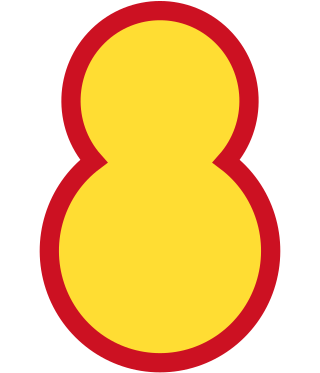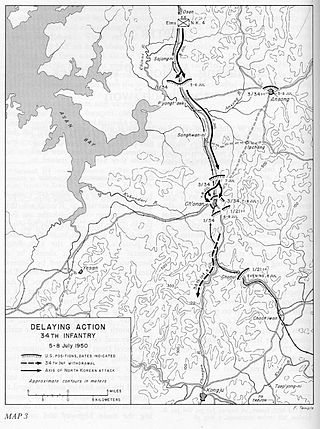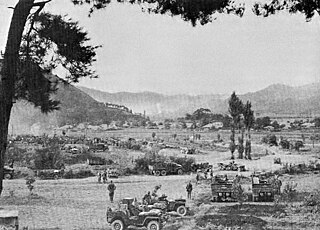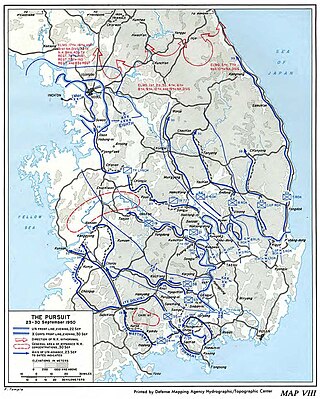
The 8th Maneuver Division, also known as Roly Poly Toy Division, is a military formation of the Republic of Korea Army and is unit is one of four divisions under the command of the VII Maneuver Corps. Before the unit was renamed on January 1, 2021, it was called the 8th Mechanized Infantry Division.
The 105th Guards Seoul Ryu Kyong-Su Armored Division is a military formation of the Korean People's Army. It was North Korea's first armored unit and took part with T-34-85 tanks in the Korean War.
The 5th Infantry Division was a military formation of the Korean People's Army during the 20th century. It was activated at Nanam, North Korea, during the early part of August 1949, composed of Korean veterans of the Chinese Communist 8th Route Army's 164th Division, which had been stationed in Changchun, China until July 1949. All non-Korean troops of the 164th CCF Division were transferred to other Chinese Communist organizations in July 1949 and in their place, the division began to receive Korean soldiers from various other units of the Chinese Communist Forces. During the latter part of July 1949, the 164th Division, with a strength of approximately 7,500 men, was allegedly transferred by railroad from Changchun to Nanam, where it was integrated into the expanding North Korean Army and redesignated the 5th Division.
The 150th Division, then 11th Garrison Division of Shenyang Military Region was a military formation of the People's Liberation Army of the People's Republic of China.
The 196th Light Combined Arms Brigade is a military formation of the People's Liberation Army of the People's Republic of China. It is one of the "showcase" units of the PLA ground force.

The 21st Infantry Regiment ("Gimlet") is a United States Army infantry regiment. The 1st Battalion currently exists as part of 2nd Infantry Brigade Combat Team, 25th Infantry Division. The regiment fought in World War II, the Korean War and the Vietnam War, as well as Operation Iraqi Freedom. Task Force Smith, the first American unit to see action in the Korean War, was derived from the regiment's 1st Battalion.

The Battle of Taejon was an early battle of the Korean War, between U.S. and North Korean forces. Forces of the United States Army attempted to defend the headquarters of the 24th Infantry Division. The 24th Infantry Division was overwhelmed by numerically superior forces of the Korean People's Army (KPA) at the major city and transportation hub of Daejon. The 24th Infantry Division's regiments were already exhausted from the previous two weeks of delaying actions to stem the advance of the KPA.

The Battle of Chonan was the third engagement between United States and North Korean forces during the Korean War. It occurred on the night of July 7/8, 1950, in the town of Chonan in western South Korea. The fight ended in a North Korean victory after intense fighting around the town, which occurred throughout the night and into the morning.

The First Battle of Naktong Bulge was an engagement between United Nations Command (UN) and North Korean forces early in the Korean War from August 5–19, 1950 in the vicinity of Yongsan and the Naktong River in South Korea. It was a part of the Battle of Pusan Perimeter, and was one of several large engagements fought simultaneously. The battle ended in a victory for the UN after large numbers of US reinforcements destroyed an attacking North Korean division.

The Battle of Taegu was an engagement between United Nations Command (UN) and North Korean forces early in the Korean War, with fighting continuing from August 5–20, 1950 around the city of Taegu, South Korea. It was a part of the Battle of Pusan Perimeter, and was one of several large engagements fought simultaneously. The battle ended in a victory for the UN after their forces were able to drive off an offensive by Korean People's Army (KPA) divisions attempting to cross the Naktong River and assault the city.

In the Battle of the Bowling Alley , United Nations Command (UN) forces defeated North Korean forces early in the Korean War near the city of Daegu, South Korea. The battle took place in a narrow valley, dubbed the "Bowling Alley", which was north of Daegu. It followed a week of fighting between the Korean People's Army (KPA) 13th Division and the Republic of Korea Army's (ROK) 1st Division along the latter's last defensible line in the hills north of the city. Reinforcements, including the US Army's 27th and 23rd Infantry Regiments were committed to bolster the ROK defenses. This battle and several others were smaller engagements of the Battle of Pusan Perimeter.

The Battle of Sangju was an engagement between the United Nations and North Korean forces, occurring on July 20–31, 1950, in the village of Sangju in southern South Korea, early in the Korean War. It ended in a victory for the North Korean forces after they were able to push troops of the United States and South Korea out of the area.

The Battle of Yongdong was an engagement between United States and North Korean forces early in the Korean War. It occurred on July 22–25, 1950, in the village of Yongdong in southern South Korea. The newly arrived US Army 1st Cavalry Division was ordered there to cover the retreat of the US 24th Infantry Division after the Battle of Taejon. The 1st Cavalry Division soldiers, however, were untried in combat, and the North Korean Korean People's Army's (KPA) 3rd Division was able to outmaneuver them and force them back.

The Battle of Masan was an engagement between United Nations Command (UN) and North Korean forces, which took place early in the Korean War between August 5 and September 19, 1950, in the vicinity of Masan and the Naktong River in South Korea. It was part of the Battle of Pusan Perimeter, and was one of several large engagements fought simultaneously. The battle ended in a victory for the UN after large numbers of United States Army (US) troops were able to repel the repeated attacks of two Korean People's Army (KPA) divisions.

The Battle of Nam River was an engagement between the United Nations Command (UN) and North Korean forces early in the Korean War from August 31 to September 19, 1950, in the vicinity of the Nam River and the Naktong River in South Korea. It was a part of the Battle of Pusan Perimeter, and was one of several large engagements fought simultaneously. The battle ended in a victory for the United Nations after United States Army (US) troops repelled a Korean People's Army (KPA). attack across the river.

The Great Naktong Offensive was a North Korean military offensive against United Nations Command (UN) forces early in the Korean War, taking place from September 1–15, 1950. It was the North Korean Korean People's Army (KPA)'s unsuccessful final bid to break the Pusan Perimeter established by the UN forces.

The Second Battle of Naktong Bulge was an engagement between United Nations Command (UN) and North Korean forces early in the Korean War from September 1 to September 15, 1950, along the Naktong River in South Korea. It was a part of the Battle of Pusan Perimeter, and was one of several large engagements fought simultaneously. The battle ended in a victory for the United Nations after large numbers of United States Army (US) troops repelled a strong Korean People's Army (KPA) attack.

The Battle of Yongsan was an engagement between United Nations Command (UN) and North Korean forces early in the Korean War from September 1–5, 1950, at Yongsan in South Korea. It was part of the Battle of Pusan Perimeter and was one of several large engagements fought simultaneously. The battle ended in a victory for the UN after large numbers of United States Army (US) repelled a strong Korean People's Army (KPA) attack.

The Pusan Perimeter offensive was a large-scale offensive by United Nations Command (UN) forces against North Korean forces commencing on 16 September 1950.

The UN Forces September 1950 counteroffensive was a large-scale offensive by United Nations Command (UN) forces against North Korean forces commencing on 23 September 1950.
















